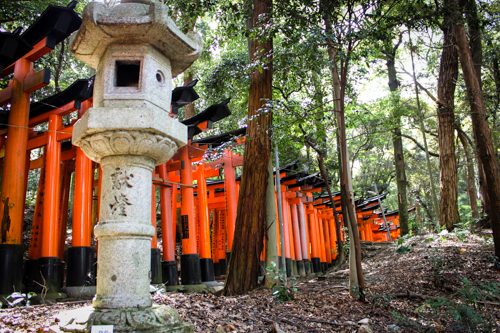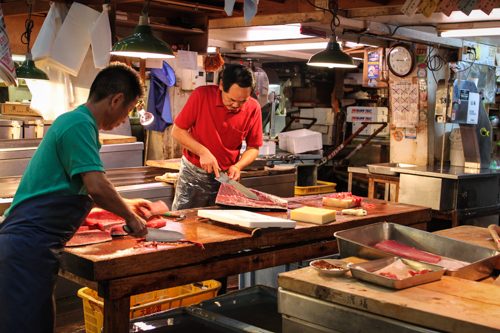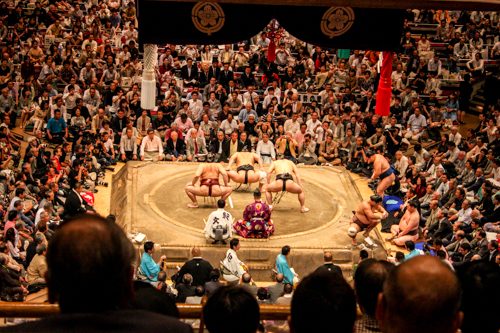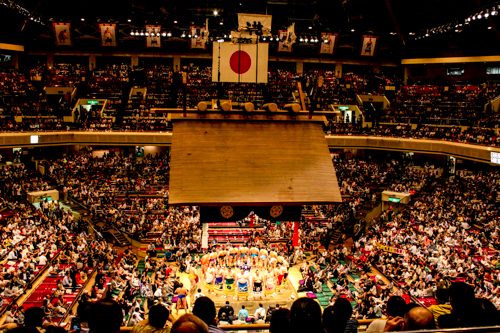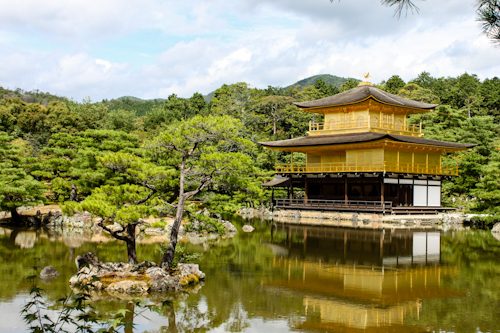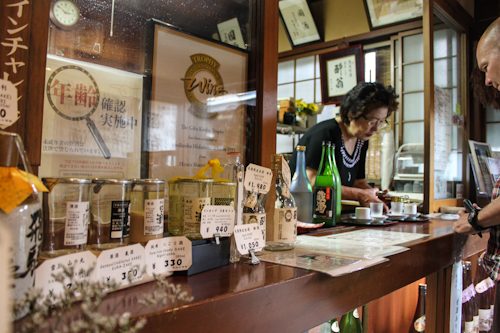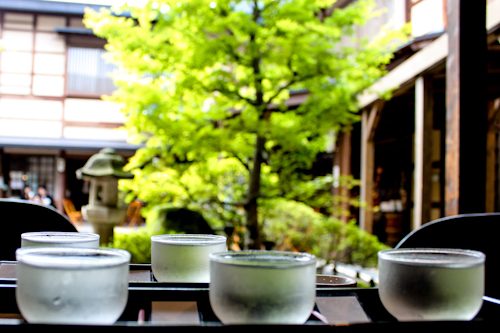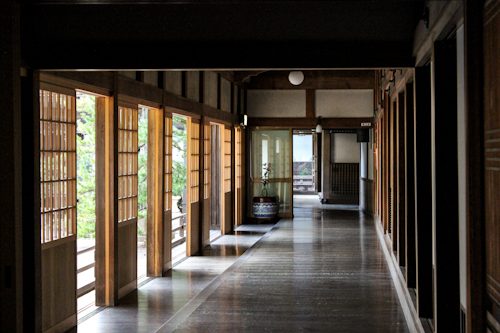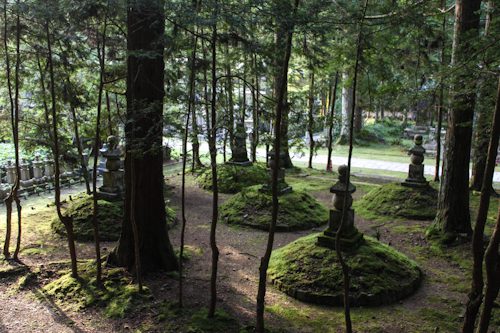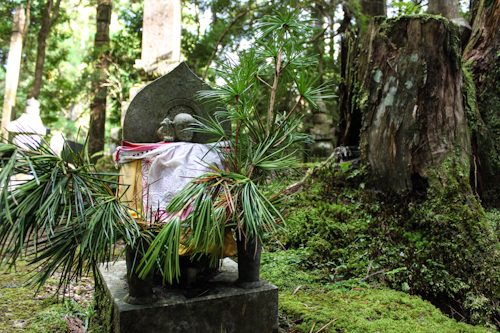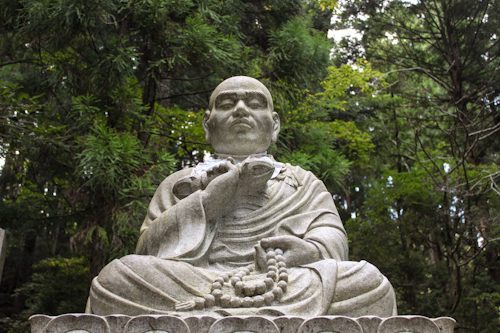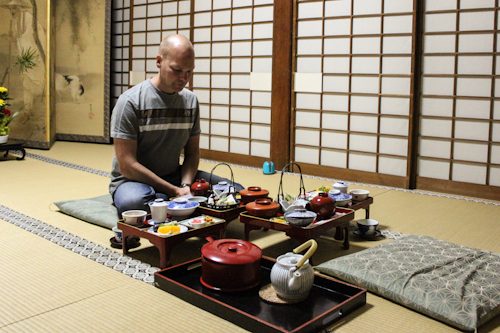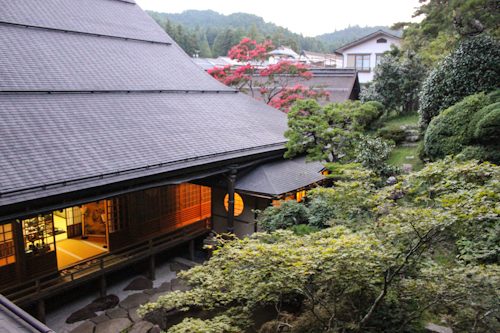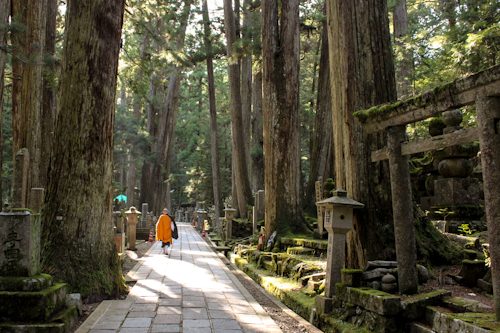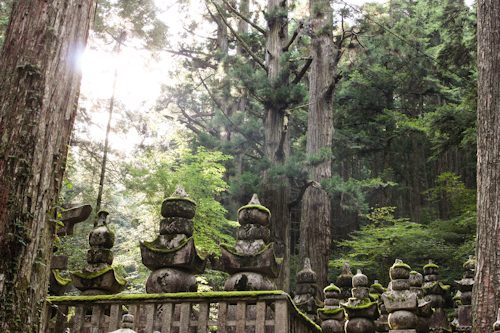Japan
Starting at the base of a mountain just south of Kyoto, the Fushimi Inari Taisha (or shrine) snakes up and through the trees providing a serene, contemplative mood. Thousands and thousands of vermillion orange toriis line the pathway making for an astounding and elegant display.
Most people keep to the bottom trails but climbing to the top will afford peace, quiet, and stunning views. It’s perfect for an afternoon away from the city.
Although we arrived at the Tsukiji Fish Market at 7am we were still far too late to see any of the real hustle and bustle that goes on in the morning. The large tuna auction was over and most of the big fish had already been sectioned and sold off.
It was clean up time and the mood felt relaxed and jovial as everyone got to finishing their morning tasks laughing and gossiping amongst themselves.
We simply wandered up and down the endless aisle ways staring wide mouthed at the endless array of seafood on display. Tuna flesh as red and rich as any beef I have ever seen, fish roe as large as marbles and as orange as the Tang juice we drank as kids, and an indescribable array of creatures, and parts of creatures, that I had never seen before.
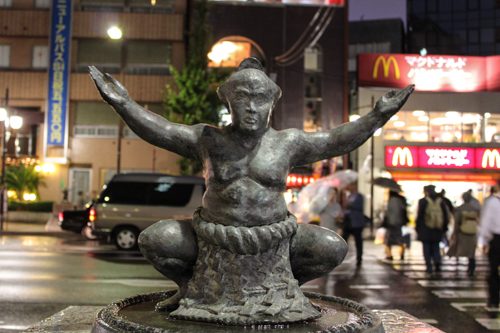 We enter the Kokugikan Sumo Stadium early, long before the crowds descend. The lowest ranking rikishi, or sumo wrestlers, are just getting started as we make our way to our seats.
We enter the Kokugikan Sumo Stadium early, long before the crowds descend. The lowest ranking rikishi, or sumo wrestlers, are just getting started as we make our way to our seats.
We’ve been in Japan for almost a month now; wrangling a language built with characters rather than letters, bumbling our way through culture and traditions hoping we aren’t offending anyone too badly, and savouring cuisine that has no equal in my eyes, and yet entering into the stadium was like entering into a whole other world again.
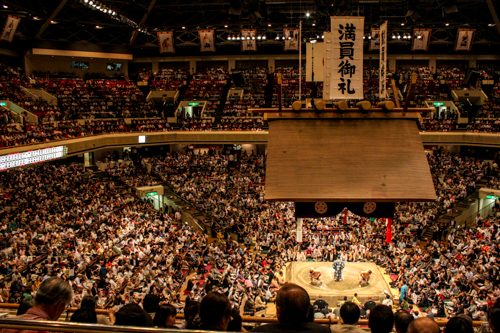 Steeped in history, riddled with culture, and defined by strong traditions, sumo wrestling is a quintessential Japanese sport. Everything means something. Every flick of the wrist, every lifting of a leg, and every turn in the ring has a reason.
Steeped in history, riddled with culture, and defined by strong traditions, sumo wrestling is a quintessential Japanese sport. Everything means something. Every flick of the wrist, every lifting of a leg, and every turn in the ring has a reason.
I am instantly fascinated.
In the causeway of the stadium, as we sit and eat our bento box lunches, the Yokozuna, or highest ranked rikishi, begin to enter. Fans, young and old, rush to the doorway; craning and peering to catch a glimpse of their sumo wrestler hero. There is a common-ness about it all though. These are the best of the best and yet they walk among the fans easily pausing for pictures, answering questions, and encouraging young boys with stories of winning and success. They are held to a high regard and they clearly stand up to it.
 The crowd swells as the day progresses and the more important bouts grow closer. We are fortunate to make a new friend; Atsushi has come all the way from Sapporo to watch the tournament and takes the time to explain the ritual and practicalities to us. We are grateful.
The crowd swells as the day progresses and the more important bouts grow closer. We are fortunate to make a new friend; Atsushi has come all the way from Sapporo to watch the tournament and takes the time to explain the ritual and practicalities to us. We are grateful.
A hush comes over the stadium as the gyoji, or referee, enters the ring. His kimono is ornate and his actions deliberate as he begins to call out in a sing song voice gesturing first to one side of the ring, and then to the other. I imagine he must be recounting some ancient story, calling on the ancestors, or blessing the proceedings but Atsushi confides that he is simply announcing the next round of wrestlers.
The sheer size of the wrestlers is daunting and yet they climb the steps to the ring with a grace and dignity that belies their heft. The cleansing ceremony is at once ritualistic and ferocious as the wrestlers attempt to intimidate each other while, at the same time, they appease their ancestors and gods. Faces are grimaced, feet are stomped, salt is strewn, and then it is time to get down to business.
Crouching down, facing each other, they stay perfectly still until some unseen influence sets them off. It is over almost before it has begun; the winner only having to force the other to touch the ground with any part of his body (even the tip of a thumb!) or place as much as a toe outside the straw ring boundary.
 The loser bows reverently and slinks away; the winner is exalted and, in the later matches, showered with gifts.
The loser bows reverently and slinks away; the winner is exalted and, in the later matches, showered with gifts.
I am pulled from the action only by the smell of fish. Looking over I see my seat mate snacking on the remnants of his bag of dried fish as casually as we might enjoy a bag of popcorn at a hockey game. This might be an ancient sport, attended in the past by emperors and kings, but today it is the every-man filling the seats and enjoying the sportsmanship and camaraderie of cheering for a favorite.
In the end it’s the ritual, the showmanship, the progression that makes the day interesting. I understood next to nothing but was transfixed for the entire day by all that was happening around me.
*******
Interested in seeing a sumo tournament yourself? If you stay in Osaka, Tokyo, Nagoya or Fukuoka you will be able to participate in one of the tournaments. Here’s some info that will help make it happen:
- There are six tournaments a year. Three in Tokyo (Jan, May and Sept), one in Osaka (Mar), one in Nagoya (July) and one in Fukuoka (Nov)
- Getting tickets was easy. The Sumo-Ticket.jp website has tons of information on the stadiums and the tournaments and allows you to book tickets also. Tickets are only available starting about 6 weeks before the tournament so set yourself a reminder to book them. I entered all my information and was sent a confirmation within a couple of days. CHOOSE YOUR SEATS CAREFULLY! Box seats are delineated by a brass bar all around the area you are purchasing; you must sit on the floor (Japanese style) for the entire time. Arena seats are western in nature; a fold down seat that I could sit on like I do at home.
- Picking up tickets was even easier. There was a booth outside the stadium that held the pick up tickets. I just showed my ID and we were in. WARNING: The tournament was sold out the day we went so be sure to get your tickets ahead of time. I overheard one whiny Canadian (!?) complaining that they had travelled SO far and couldn’t they just, please, be let in. Don’t let this be you!
- It’s not that hard to figure out what’s going on. There is plenty of information on the internet but we also received a fabulous packet of information (in English) at the gate. The beautiful pamphlets explained about the practicalities of the stadium and about the history and ritual of the sport. There is also a live, English, radio broadcast available (we didn’t use this). As I said above, people are super friendly and helpful and it won’t be hard to find a fan who can help you understand what’s happening.
- Spend some time. The best part of the day was watching the progression of all that was happening. The early, junior, matches are a great time to learn about the sport so you can enjoy the later, more senior, matches with some knowledge behind you. People come early and bring snacks to make an afternoon of it. Do the same; either bring something with you or there are lots of concession stands selling bento boxes, yakitori, popcorn and dried fish snacks or you can head to one of the basement restaurants offering chankonabe stew (the official meal of sumo wrestlers). We spent 8 hours in the stadium (11am to 7pm) and never once felt bored or like time was dragging; it was one of the best days we had in Japan
*******
I’m working on a new project! The Global Bookshelf will be a place for you to find books and stories that will connect you to the trip you’re already planning, or the one you are dreaming of. I would love it if you would sign up for updates; you can use the form right there in the sidebar. And thanks!
The Global Bookshelf. Connecting travellers to a world of stories.
Train travel in Japan is a treat. Not only do they leave exactly on time but they are quiet, super clean, and comfortable. The extensive network of train tracks links in nicely with an even more extensive network of subway, bus and ferry routes that make it really easy to get pretty much anywhere in the country.
It’s not cheap though.
Luckily the largest rail consortium in the country, JR Rail, offers a pass that can make it significantly more budget friendly.
Getting, and using, a JR Rail Pass is easy. The JR Rail Pass website has everything that you need to know; who is eligible for a pass, how and where to get a pass voucher, pass types and prices, how and where to exchange your voucher for a pass, and how to use the rail system. We found using the pass, and getting around, to be fairly easy. A quick note about the type of pass; don’t bother paying the premium for the Green Pass. We found the Ordinary cars to be more than comfortable and, from looking through the windows, couldn’t actually see how the Green cars were any different!
Is a JR Rail Pass worth it? Well, I’m not entirely convinced that it saved us money.
As we were in Japan for 27 days, and planned to travel around the country for about two and half weeks in between our stays in Tokyo, we opted for the 21 day pass. This cost us $749 CDN each; a good chunk of change out of our budget! (All numbers here are for one person.)
I, of course, tracked every train trip we took as I wanted to see if the pass would pay for itself.
And here’s where I start to doubt whether the pass was worth it.
A ticket on a JR Rail train is a ticket to get on the train; it doesn’t guarantee you a seat. On any train there are ‘Reserved Seat’ cars and ‘Unreserved Seat’ cars. I tracked what it would have cost us just for the train ticket and what the seat reservation cost us.
For the trips we took, the total for ticket cost plus seat reservation was $810.65. The JR Rail Pass cost us $749 so it appears that we saved $61.55.
However I don’t think we needed to reserve seats for every trip we took. We always reserved seats (where possible) because it was a service included in the JR Rail Pass but, most often the ‘Unreserved Seat’ cars we more than half empty and we could have easily found a seat without ‘paying’ the seat reservation fee.
So, if I look at just the ticket price ($496.10) versus the cost of the pass ($749), it appears we lost $252.90!! Each!
To be fair; there were a couple of trips where it might have been difficult and anxiety inducing to find a seat. We travelled on one long weekend that had increased train traveller traffic and on another day something must have gone wrong as a number of trains coming from one direction were significantly late which set most of the travelling public into a tizzy but that we didn’t have to worry about because we had a guaranteed seat.
Why did we not see significant value in the pass and what can you do to ensure it’s worth your money?
We traveled quite slowly; activating our passes in Tokyo to travel to Kyoto and then stayed there for a week. We stayed 3, 4, or 5 days in all of the other destinations we traveled to. The JR Rail Pass is best for those who will be traveling significantly during the time the pass is activated.
If you are considering getting a pass, take a close look at your itinerary – if you will be moving often during the duration of your pass, then it will likely be worth it.
In the end I can’t say we shouldn’t have gotten a pass. Having the pass made it fast and easy to access and use the train system. We never quibbled over whether we would go somewhere based on the cost of the train to get there and we always knew that we would have a seat. Peace of mind and ease of use trump the few dollars we may or may not have saved in the long run.
 For us the primary mode of transportation while in Japan was the Japanese railway system; a combination of trains and metros (subways). For people who aren’t train geeks, the differences can be subtle; I’ll just refer to them universally as trains going forward.
For us the primary mode of transportation while in Japan was the Japanese railway system; a combination of trains and metros (subways). For people who aren’t train geeks, the differences can be subtle; I’ll just refer to them universally as trains going forward.
What is more important is the difference between the national Japan Rail (JR) system and private systems. The various companies of JR operate a vast network across the country including the wonderful high-speed Shinkansen. There are also many non-JR or private companies operating trains in popular areas. Why is this important you ask? The JR Pass!
Train travel is not cheap, but foreign nationals can purchase an unlimited JR travel pass voucher before they arrive in Japan and exchange these for JR Passes when they arrive. It is important to note that you cannot purchase these in Japan! The small catch is these are only valid on the JR system. For most travellers this won’t be a problem as JR services most popular destinations including a complete network of trains around Tokyo.
If you are heading off the beaten path, some planning with tell you if it is a private or JR service you need. Details about JR pass options and purchase can be found on the Japan Rail Pass website. For train trip planning on either JR, or private, lines we used the Hyperdia online schedule tool.
One of the things that is awesome about Japan (there are many awesome things about Japan!) is that all train stations are uniquely named. If you know where you are and where you need to go, you just put those locations into the search and pick the date and arrival/departure time. Additional search filters include service type, and JR versus private companies. As expected, results focus on travel efficiency; this may not accommodate a break for lunch if you are a leisure traveller. Good news again – the full schedule for each train on a multi-train routing is accessible and you can pick an earlier or later train and add a break for yourself, which we often did on longer legs. Train stations offer up all kinds of dining options; from stand up noodle stands to full on restaurants and bento box options. It’s worth it to take a break and grab a meal, especially when you know that it’s more than just grotty sandwiches on offer!
Stand Up Noodle Stall in a Japan Railway Station
Old fashion paper maps or online maps will help to identify the name of closest train stations to you or your destination. All of the guesthouses, apartments, ryokans, and minshukus we stayed in provided information about closest train stations and often included information about surrounding attractions and temples and how to get to them using the trains.
Even if you opt for a JR pass you will still need to reserve a seat if you are taking Limited Express or Shinkansen trains as these can fill up more than the local service. Most train stations have staff that can sell you tickets or arrange reservations. The level of spoken English will vary significantly so help yourself and the agent by writing down the information before you get to the window. Important bits; date of travel, train name and number, departure station, departure time, destination station and destination time.
Of course, In the land of vending machines, you can bypass the person and go directly to ticket machines. Each one I encountered had an option for English instructions. Fares are based on the travel zone concept. Think of wider and wider circles on the map centred from where you standing. The fare is the same for all destinations in each circle and there are big boards with the likely stations and fare cost above the ticket machines. Buy a ticket for the fare value you require and you are good to go.
Train ticket vending machine. Not as scary as they look!
Information about which platform your train will be arriving on is available past the gates on large signs posted overhead. The signs will flip between Kanji and English so be patient. On the platform, you will find signage to indicate where your car will stop if you have a reservation. The signage will either be on the ground with directions for lining (queuing) up or suspended overhead; find where your car will stop and line up with the locals.
 Remember the trains are incredible efficient. Some may only stop for less than a minute to allow passengers off and new people on. Be ready when the train arrives at the station; you’ll have to board quickly. If you are a rock star and want special treatment, you’ll have to hire a car.
Remember the trains are incredible efficient. Some may only stop for less than a minute to allow passengers off and new people on. Be ready when the train arrives at the station; you’ll have to board quickly. If you are a rock star and want special treatment, you’ll have to hire a car.
 I love traveling by train. The Japanese railway system takes it to a whole new level; impeccably clean, efficient, and reliable. There is no better way to get around the country.
I love traveling by train. The Japanese railway system takes it to a whole new level; impeccably clean, efficient, and reliable. There is no better way to get around the country.
**Click Here to see Travel To Japan: What Does It Cost (Part One)**
There is no doubt that Japan is an expensive country to travel in. Our travel to Japan was, in fact, the most expensive trip we’ve ever done.
It was also the best trip we’ve ever had. It changed our lives; it was here, during this trip, that we finally decided to take the next GiantStep to leave Canada. It was worth every single yen.
We broke our expenses down into five basic categories:
Accommodation
 This wasn’t a backpacker trip so I wasn’t necessarily looking for the cheapest option but I was cognizant of price and wanted to get the best I could for the money I was willing to spend.
This wasn’t a backpacker trip so I wasn’t necessarily looking for the cheapest option but I was cognizant of price and wanted to get the best I could for the money I was willing to spend.
We stayed in a mix of accommodation styles; apartments, Tokyo hotels, guesthouses, traditional ryokans, local minshukus and even a temple. I placed links in the spreadsheet next to each entry – I recommend every place we stayed. Some were very reasonably priced (an apartment in Tokyo for $100/night!) and some were very expensive ($300 for a ryokan stay…but it included an amazing dinner and breakfast).
On average we spent $123.80 per night. If I factor out the meal costs of the two most expensive stays (that included meals), the average drops to $112.88; we would be hard pressed to travel in our own country for this cost!
Transportation
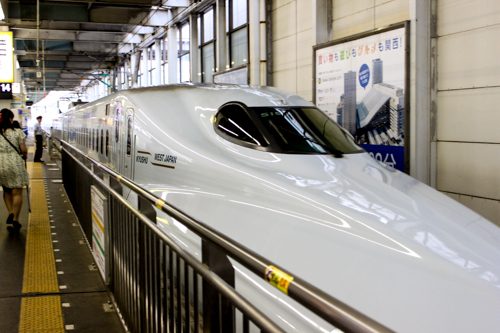 Flights and trains were the big budget items here.
Flights and trains were the big budget items here.
Our flights from Calgary to Tokyo (return ticket) cost $3128.24 – that’s quite the chunk of change out of a budget! I’m glad we were able to spend a month in Japan because I would be hard pressed to think that paying that kind of money for a two week holiday would be worth it.
The three week JR Rail passes were the next biggest transportation expense at $749 each – $1498 for the two of us! They turned out to be worth it – although just barely.
We spend just over $400 on other non-JR train tickets, subway rides, bicycle rentals, and the occasional taxi.
Food and Drink
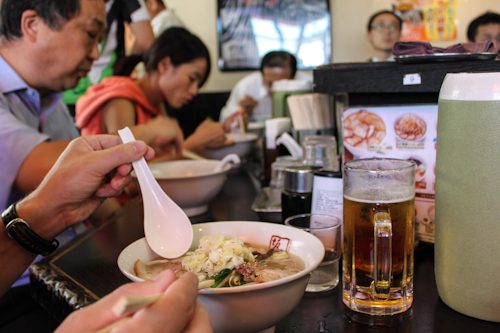 There really is nothing Jason and I enjoy more than spending time over a meal, or whiling away an afternoon in a pub so it’s no surprise that our food and drink costs were high.
There really is nothing Jason and I enjoy more than spending time over a meal, or whiling away an afternoon in a pub so it’s no surprise that our food and drink costs were high.
We stayed in apartments for half our trip so were able to self cater breakfast most of the time. We love spending our mornings lounging around, catching up on the interwebs, drinking coffee, and snacking on whatever we could find at the grocery store so apartments fit the bill nicely. It turns out that going out for coffee in Japan is an expensive affair, sometimes costing as much as $5 per cup for regular coffee so making it at ‘home’ was very budget friendly!
After a day of sightseeing we usually head back to our room to enjoy an early evening cocktail before dinner. Alcohol is fairly inexpensive and widely available in shops so we could just pick something up on our way. Going out for a drink, however, can be fairly pricey; probably no more expensive than the places we frequent here in Calgary, although Japanese beer is a little lacklustre and, at home, we don’t go out every night.
We really didn’t think too much about the budget when looking for a place to eat. We tend to enjoy middle-of-the-road establishments and knew there was room in our budget to accommodate what we like so we weren’t out to find the cheapest meal at any point. A few times, when in particular areas that were known for a certain meal, we would splurge but mostly we stuck to ramen houses, kaiten (conveyor belt) sushi shops, and izakayas (pubs). A few times we picked up some sushi from the grocery store but that was more about wanting to stay home than worrying about the budget.
We almost always had a drink (or two, or three) with a meal; these are not broken out in the budget sheet but you could probably half all the costs there to determine a non drinking budget – often our booze bill the same as the food bill. Definitely would be much cheaper to travel as a tee-totaller but it’s just not our style.
On average we spent $105.58 per day on food and drink.
Attractions/Activities
We went to Japan to be in Japan. It was a tiny expat experiment whereby I wanted to really pretend that I lived there. Sure, we visited temples and shrines, took a tour and a cooking class, and revelled in the Sumo Grand Championship, but what I really enjoyed was just riding the trains, going for dinner, cruising the grocery store aisles, and wandering around the streets imagining that this neighbourhood was my neighbourhood.
I think our attractions/activities costs are fairly low at an average of $20/day.
Miscellaneous
Miscellaneous holds all the other stuff. We needed some toothpaste. We did laundry once. Luckily, we are not souvenir people so this category usually stays quite low. In fact most of this category is taken up by the pocket wifi device we rented to stay connected the whole time.
We traveled through Japan for 27 days. It cost us $11,965.52 – I had budgeted $12,000 so I’m happy to be under budget.
Here is the entire OneGiantStep Japan Budget should you care to see more of a breakdown.
Our trip to Japan was everything I wanted it to be, and more. It was worth every single penny.
It is the attention to detail, in so many ways, that I love about Japan. Even wandering down the most mundane of streets I was amazed at the beauty that I found underfoot.
As with many things, the Japanese take manhole covers to a whole new level. Even the simplest among them had beautiful cast designs; the more ornate ones were storyboards of the places in which they were found. Flowers, deer, paper cranes, and sake breweries; all represented in a most unusual way.
“Can’t you just imagine living here?”
On this trip, more than any other, this thought kept creeping into our minds and conversations. Not only because we are looking for a new home but also because we used apartments for this trip and so really could feel as though we had moved in.
We were especially connected to our Tokyo apartment. We stayed in it for three days when we first arrived and then returned for the last 6 days of our trip. As we had already settled into the space and explored the neighbourhood a bit it really felt like we were returning ‘home’.
Want to see what it looked like? Check out this virtual tour I hosted:
It’s more than a cute, little kitchen and a comfy bed though, it’s our place in a real neighbourhood.
Downstairs, the narrow streets buzz with activity coinciding with the time of day; early morning sees bleary-eyed salary men making their way to the nearby train station before the uniformed school boys and girls giggle and gossip along the route to school and then there is the mid-day pilgrimage to the markets and shops by moms and wives as they plan and prepare dinner for their families.
We spend our days out exploring the sights of the city but return late every afternoon to relax and enjoy a cocktail at home. We have not eaten dinner outside of the four square blocks surrounding us. There is no need to; every evening we stroll down a different street and discover ever more cute, interesting, little places calling our name. Izakayas, yakitori stands, ramen shops, sushi bars, and tempura joints abound – we could try a different one every night for a month and still not get to them all. I love the abundance.
 We start to recognize people…and be recognized. The clerk at the grocery store knows that we remember to bring our own bags. The young man making custard fish sees me coming and wraps my daily addiction up for me. The call of “Irasshai” from the sushi chefs feels warmer as we walk in for the third time this week.
We start to recognize people…and be recognized. The clerk at the grocery store knows that we remember to bring our own bags. The young man making custard fish sees me coming and wraps my daily addiction up for me. The call of “Irasshai” from the sushi chefs feels warmer as we walk in for the third time this week.
 We are starting to fit in with the ebb and flow of what happens in real life in this real life Tokyo neighbourhood. This is what I’m looking for; this sense of home and yet not quite knowing how it all works. I love to travel, but I also love routine. It is during this trip, during this time spent in apartments so far from home and yet feeling so much like home, that cements the whole wanna-be expat idea.
We are starting to fit in with the ebb and flow of what happens in real life in this real life Tokyo neighbourhood. This is what I’m looking for; this sense of home and yet not quite knowing how it all works. I love to travel, but I also love routine. It is during this trip, during this time spent in apartments so far from home and yet feeling so much like home, that cements the whole wanna-be expat idea.
In fact, during our last few days here in Tokyo we set about re-imagining ‘our’ apartment as a more permanent home; we could put a linen closet in the toilet room, a few posters on the wall, a tiny couch and table in with the bed in the other room, perhaps a small rolling kitchen island would increase the kitchen counter space. We had it all figured out.
 Sunny afternoon to fill? Check.
Sunny afternoon to fill? Check.
Quaint, riverside, neighbourhood filled with sake breweries? Consider it filled.
Tucked amongst the craft makers, souvenir shops, and tea houses in Takayama are numerous sake breweries. In winter, when sake brewing is underway, it is possible to tour the breweries and learn some of the secrets to this ancient craft. Being as it was summer when we visited we had to make do with tasting the fruits of last years labour. Oh, the hardship.
Seeking out the hanging cedar balls indicating sake availability, we wandered the towns streets looking for tastings. Some breweries offer free tastings; good for the wallet but not as relaxed as when we paid a small fee to enjoy the small glasses in the tasting room where we could take our time and not feel pressured to purchase.
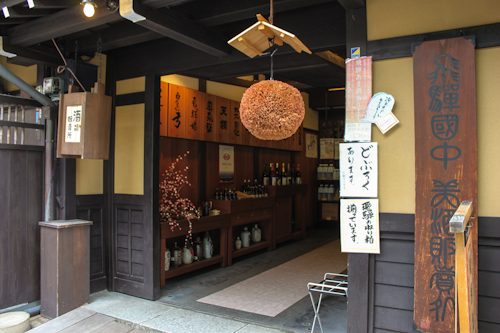 Sake is all about the water (pure, fresh, and directly from the mountains here), the rice (polished down to its starchy essence), and the koji (the mold that converts the starch to sugar so the yeast can convert it to alcohol).
Sake is all about the water (pure, fresh, and directly from the mountains here), the rice (polished down to its starchy essence), and the koji (the mold that converts the starch to sugar so the yeast can convert it to alcohol).
There are various grades and styles of sake but, quite frankly, I found them all to be quite similar. When tasting side by side I could taste subtle differences in sweetness, dryness, and fruitiness but, when simply enjoying a glass with a meal, each one tasted pretty much like the last. I enjoyed them all, don’t get me wrong, but I think I was expecting the range of flavours found in wine and beer.
Some of the places we visited were more than 300 years old. In Canada we’re lucky to find a place that’s been around 50 years!
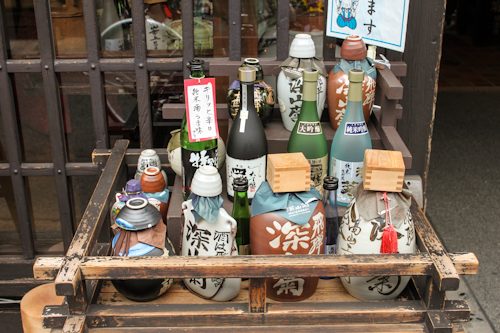 There were large, formal, tasting rooms in the bigger breweries.
There were large, formal, tasting rooms in the bigger breweries.
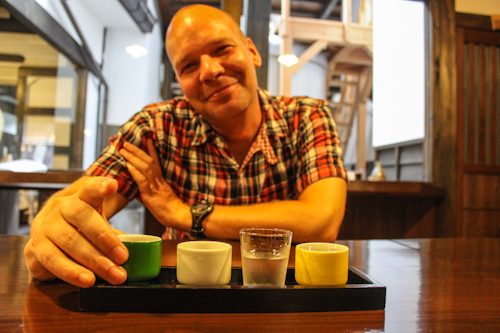 Others were small, family run places where we could hear the kids playing in the back room.
Others were small, family run places where we could hear the kids playing in the back room.
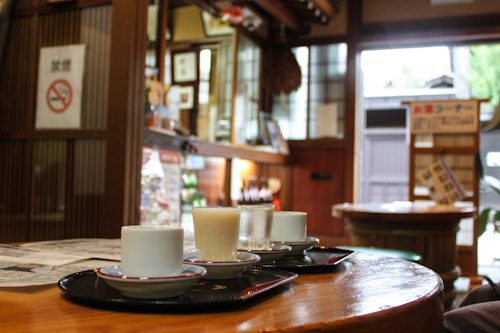 This one had a beautiful courtyard great for people watching.
This one had a beautiful courtyard great for people watching.
All were worth the time spent on a sunny, relaxed, afternoon.
When visiting a place I never try to find the ‘best of’ food.
I don’t need to find the best sushi in all of Tokyo; it’s likely that any sushi I have here will be better than any I have ever tasted. No need to battle the crowds, pay the ‘best of’ prices, or spend tons of time searching out the teeny, tiny, joint; I can just go downstairs from our apartment and walk into any place to get the best Japanese food I know.
What I do like to do is find a representative food and try it over and over and over again. Is it the same everywhere or are there regional differences in flavouring, spicing, and technique? Does it make a difference if I have it as ‘street food’ or in a restaurant? How does it differ from the version I can find at home?
[adsenseyu1]
In Greece we sampled calamari across the many different islands we visited. In Germany of course it was the beer and pretzels. Nepalese eat dal baat every day; it may be the same basic ingredients every day but there were small differences in flavour from region to region. Kebap in Turkey seemed to be the same everywhere, and ceviche in Peru depended on what seafood was available.
Here in Japan we knew it would be ramen; we even practiced our slurping at home to get ready! Simple ingredients (broth, noodles, pork, bean sprouts, corn, bamboo shoots, green onions and sometimes egg) are combined in a variety of ways that keep us coming back for more. We’ve found at least 10 types!
- Simple Pork Ramen. This was the very first bowl of ramen on our very first day in Japan. We stopped in a small, family run, shop while meandering through a neighbourhood in Tokyo. The pork broth was nice and light, the chashu (roasted pork) wasn’t too fatty, and the noodles were nicely cooked. We were hooked!
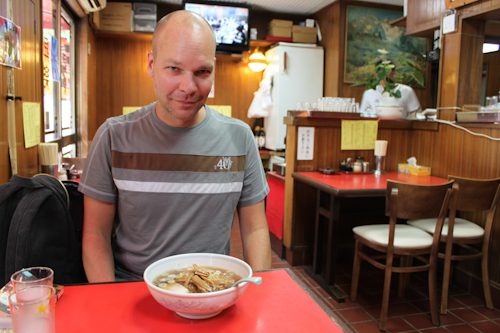
- Wonton Ramen. I didn’t know that wontons could be part of ramen but I guess seeing as the whole dish is from China originally I shouldn’t have been surprised. This was one of our favorites – the broth was light and a touch salty and the chashu was the best we’ve had; it was like the rich end of a pork roast.
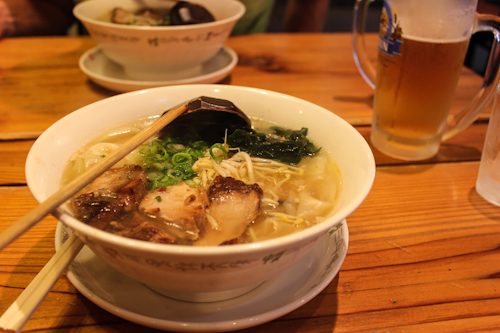
- Rich Pork Ramen. I separate this one out because it was completely different than the earlier pork versions we’d had. Mike, who pointed us to this joint, described the broth as being made from a whole pig being cooked for hours and hours. It was rich beyond belief – thick and fatty and porky. So good that I forgot to take a picture before it was gone.
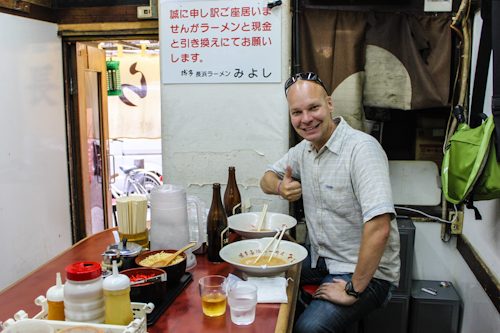
- Fast Food Ramen. This was the most disappointing of them all. There must have been 10 ramen places on this department store floor; all of the type where you choose and pay through a vending machine before heading inside. We thought that ‘King of Ramen’ must be the best so we fumbled through the vending machine process and went inside. The place was okay but the ramen sucked. The ‘broth’ was more like a gravy and was too salty for me – I don’t even remember the chashu – just that I couldn’t drink enough beer to finish the bowl. Our only ramen fail.
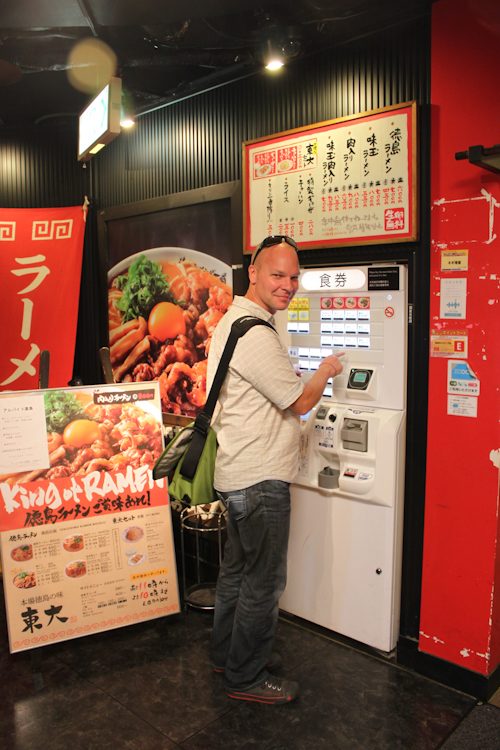
- Miso Ramen. I really like this one – it is, as the name suggests, made with a miso broth rather than pork broth. This in no way means it is vegetarian though as I’m pretty sure it’s a pork based broth with miso in it for flavouring – plus there was still some healthy chunks of chashu in there. It was slightly salty and had great unami, or mouth feel.
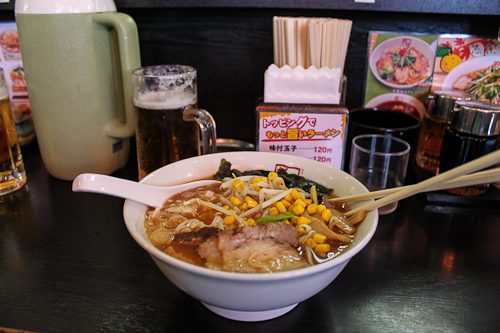
- Fish Broth Ramen. Another one I was not expecting and had never heard of. This small shop in Hiroshima served only fish based broth, either with soy added or not. Everything else about it was familiar; noodles, chashu, bamboo shoots, nori. The plain fish broth one was a little too ‘fishy’ but when combined with light soy sauce it was an interesting twist.
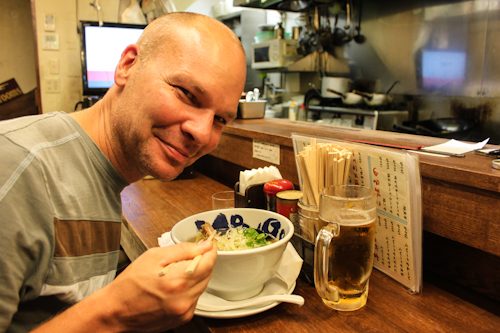
- White Leek Ramen. A pared down, lighter, version with shaved white leek on top. The leeks add a great onion flavour to the broth and help to cut the richness of the chashu. One of my favorites.
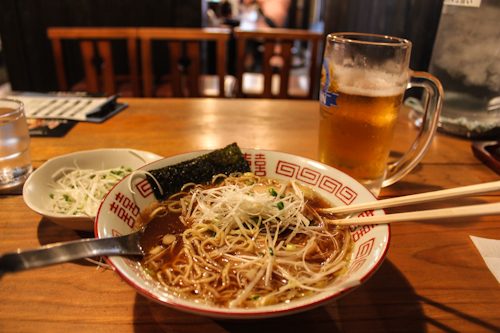
- Garlic Ramen. At this small shop in Takayama there was a bowl of peeled garlic on the table along with a grater; a do-it-yourself seasoning kit.
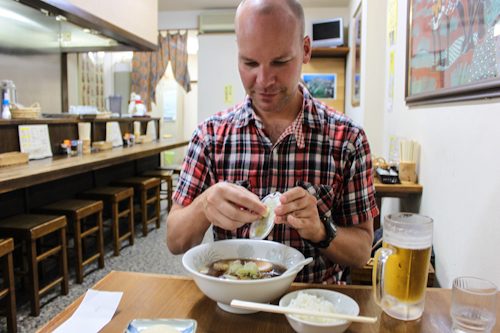
- Ham and Egg Ramen? Perhaps our lack of language means that we actually ordered this version, or maybe this is just how this railway station makes their ramen, but ham (although a laudable pork product) is no substitute for chashu in ramen. It was not a memorable version other than for this oversight.
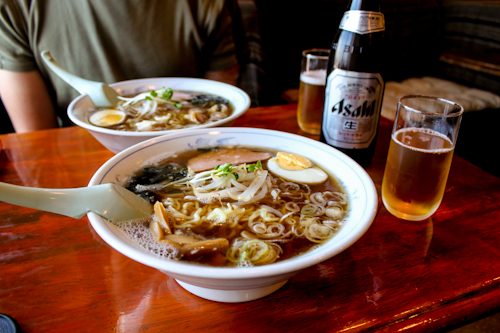
- Shio Ramen. I wasn’t sure we were going to see this version and then today, on almost our last day, it appeared on the English menu we were given. Shio means salt; it was a very lightly salted broth with a pork back flavor – the shio broth completely enhanced the flavours of everything else in the soup and ended up being Jason’s favorite ramen.

Who knew there could be so many different varieties of a basic noodle soup? I think this is one dish that I would never get tired of.
What about you? Do you try the same food over and over again to see how it changes?
Bidding the city goodbye at the Hashimoto train station we head into the hills toward Koya-san.
Winding its way through the small, but steep, slopes covered with cedar, pine, and bamboo, the train slowly empties at each station until it is just us, one other tourist couple, and a few old men on their way to the temples.
Switching to a cable car we quickly realize just how steep these hillsides are as we are winched straight up the side of one to the Koya-san bus station where a final bus ride will make its way through the mountains like an amusement park ride.
I have already confessed that, although I thought I would learn a tremendous amount about Buddhism and Shintoism on this trip, I have actually found that I am, at best, an interested observer. It is perhaps surprising then that we have come here, to one of the most important Buddhist areas in the country, to stay in a temple and take part in a morning ceremony. And that I loved it.
Shojoshin-in is a beautiful temple. Wood floors polished by centuries of feet shuffling over them, paper paneled walls, and tatami mats add to the atmospheric experience. It is quiet and serene; yet my imagination gets the best of me and I can easily see ninjas running loose on the roof and through the inner garden. I take note to sleep with one eye open lest one should drop in on us in the dead of night.
The only other reason we have come here is to wander through the cemetery at the doorstep. Set amongst cedar trees hundreds and hundreds of years old are thousands of grave markers and shrines, the oldest one dating back to 997. It is a contemplative walk up to the Toro-do, or Lantern Hall. We walk, and talk of our future plans; of moving away, of being more sure now than ever, of feeling so far away from home, of liking it.
Incense and the droning melody of a chanting monk hang in the air as we climb the stairs of the main hall. We sit and watch, and listen, under the light of hundreds of lanterns before turning back through the forest as dusk sets in.
Dinner is a private affair. We are shown to our own tatami mat dining room and opt to leave the sliding screens open so we can have a view of the pond and can hear the trickling water as we eat. It is simple, and beautiful, and delicious.
Bath time is a public, and naked, affair. We bathe immediately after dinner hoping that the other guests are still dining and we can bathe alone. Our plan works and we are each able to enjoy the large, wooden, tub privately. It is quiet, warm, and relaxing.
Bed time is early. My self imposed technology retreat means I can catch up on the book I’ve been reading, enjoy some green tea, and relax in the alcove of our room over looking the garden before crawling into the warm futon and duvet bed for the night.
Morning is marked by the gonging of a bell at 5:45. We hurriedly dress and find our way to the main hall by following the sounds of monks chanting. We watch and listen, mesmerized by the sounds of the voices, and bells, and cymbals, until we are invited to take part by adding incense flakes to the burner at the foot of the shrine.
After breakfast we take another walk through the cemetery and find we have it almost all to ourselves. The morning sun is peaking through the trees and there is nothing but peace and quiet.
Perfect.
________________
I’m posting pictures of our Japan trip everyday to the OneGiantStep Facebook page. Come on over, give us a Like, and have a look at what we’ve been up to every day!




